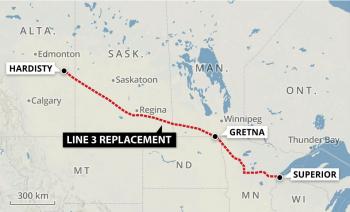By Shari Narine
Windspeaker Contributor
REGINA
As the Indigenous Advisory and Monitoring Committee for the Line 3 pipeline replacement project completes its second day of a two-day strategic planning session in Regina on April 27, one member says it will take at least another six months before the impact of the work undertaken by the committee is felt.
“You’ve got to give us time to set it up and then we go out to practise it. Then we report on it. We garner feedback from the impacted communities and then we mean to do better based on engagement,” said Norine Saddleback, Treaty 6 member and one of four Alberta representatives on the Line 3 monitoring committee.
Saddleback was appointed in June 2017 as one of 16 Indigenous members on the committee, representing 109 First Nations and Métis communities in Alberta, Saskatchewan and Manitoba, where pipeline construction will occur between Hardisty, AB and Superior, WI. The multibillion-dollar Line 3 Replacement Program is the largest project in Enbridge history.
The committee is rounded out by federal government representatives for Natural Resources Canada and the National Energy Board (NEB). The committee held its first meeting last October.
According to its terms of reference, the committee is mandated to provide “input and advice to the NEB with respect to environmental, safety and socio economic aspects” relating to the 89 conditions established by the NEB when giving approval to the Enbridge project. The terms of reference also state that the advice may be “modified or rejected” by the federal government or the NEB with written reasons provided.
But Saddleback is “pretty confident” that advice provided by her committee will be followed because not only is this the first time such a committee is not proponent-formed, but it’s also the first time that Indigenous people have received training.
“We will have our people for the first time ever, Indigenous people walking their traditional territory, giving their views, just not their views, but their perspective,” said Saddleback.
The Indigenous Advisory and Monitoring Committee is billed as operating “without prejudice,” meaning the committee neither supports nor opposes the Line 3 project. Decisions are reached through a consensus model.
“The message is that we collaboratively come to terms with our shared view in the best interest of indigenous peoples in a new-found process. Never have Indigenous people co-developed a process,” said Saddleback.
The committee does not replace one-on-one consultations or engagements between First Nations and the government.
In the 2017-2018 fiscal year, the federal government distributed $1.5 million to the Indigenous communities to fund a variety of activities, including training for monitoring; developing a monitoring framework; completing traditional land use studies; and emergency response planning. Fifty-four communities applied for and received funding.
The committee also hired consultants to review the filings submitted by Enbridge to the NEB, which detail Enbridge’s progress towards meeting the 89 conditions imposed on the project. Also reviewed were the daily construction monitor and Aboriginal monitor reports for 2017-18.
“The review is currently being compiled into a report and recommendations table,” said Steven Rowe, senior advisor with Natural Resources Canada. “This report and associated recommendations will inform engagement with impacted Nations… and (will educate) Nations on how they can use the information from the filings review to ensure the protection of their interests, including traditional land use.”
Engagement with Indigenous communities will include technical briefings to leadership and communities and Line 3 committee monitor training, Rowe says.
Having Indigenous “boots on the ground” in the pre-development stage of pipeline construction will be invaluable in identifying both the monitoring and policy gaps that need to be addressed, says Saddleback.
“We are doing something that’s unprecedented in terms of treaty relationships. I believe this is a good partnership. It is a partnership where we are ensuring that the Indigenous lens becomes part of environmental monitoring and that our people, for once, hit the ground running. We haven’t had that before,” said Saddleback.
And as far as Saddleback is concerned, calling the process “politicized” is unfair.
“You have to set up the process and that don’t come easy in a new wave of decision-making and award-winning boots-on-the-ground process. You’re not going to just do it without setting the mandate in a co-developed process and, so for, anybody to say that it’s a politicized process, I think that that defies the fact that you haven’t even given us the opportunity in a one-year annual review to showcase what we’ve accomplished,” she said.
Saddleback is the only member to serve both on the Line 3 monitoring committee and the Trans Mountain advisory and monitoring committee. She has also been a director for 15 years on consultation guidelines with the Alberta government and worked in various First Nations as a director for consultation and accommodation efforts within Alberta. She was raised in Maskwacis.

